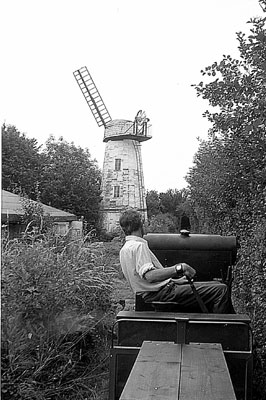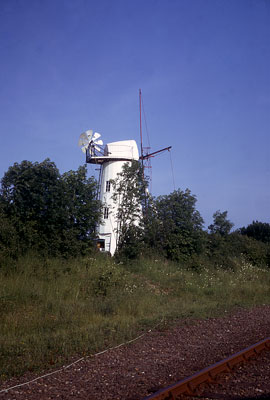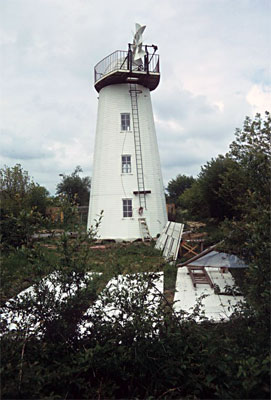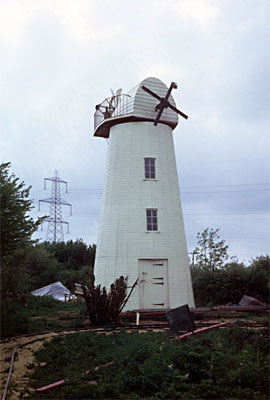
|
Yaxham
replica smockmill |
|
Yaxham replica smockmill was built in the 1970s beside the Yaxham Light Railway by David Charles Potter to generate electricity and was sometimes known as Potter's Folly. The mill lasted into the late 1980s before being dismantled. |
|
During the first year of operation the mill was beset by a variety of problems - |
|
20 sided smockmill, horizontally boarded with ship-lap, on a timber foundation anchored with iron girders. |
|
The 'windmill' near Yaxham Station was built 1974/5 by David Potter, a Dereham builder, on land leased from British Rail, with the intention of providing electricity to light his chicken houses and perhaps later, his own house nearby. |
|
Iron upright shaft connects with half a lorry axle standing on differential, using lorry brake on axle as mill brake. Lorry transmission shaft drives 4 ft. (?) wheel, which by belts drives two generators. |
|
Disaster No. 1 |
 |
| c.1986 |
This view shows No.7, a Ruston & Hornsby 16hp 2-cylinder diesel loco (works no. 170369), built in 1934 and supplied new to Chesterfield Sewage Works. This was also acquired in 1982 and is seen in July 1986 year running on the site of the present YLR. Much has changed since then, the derelict replica windmill has been replaced by a 3-road engine shed and much track-laying and landscaping has taken place. |
 |
June 1975 |
 |
 |
|
c.1975 |
c.1975 |
This mill was built by David Potter for generating electricity; he was way ahead of his time. He also built the small gauge railway and saved Yaxham station after it was closed. Ray Taylor - 30th March 2015 |
|
1974/5: Mill built by David Charles Potter to generate electricity |
If you have any memories, anecdotes or photos please let us know and we may be able to use them to update the site. By all means telephone 07836 675369 or
|
Nat Grid Ref TG00351013 |
Copyright © Jonathan Neville 2011 |